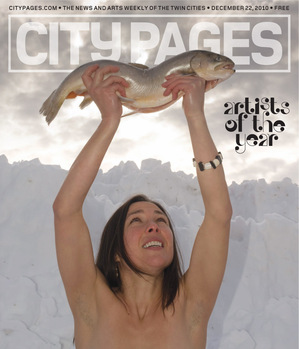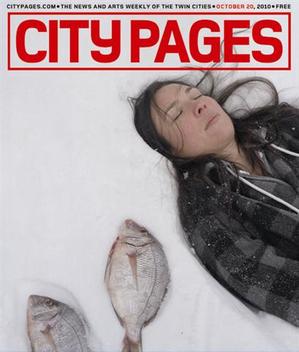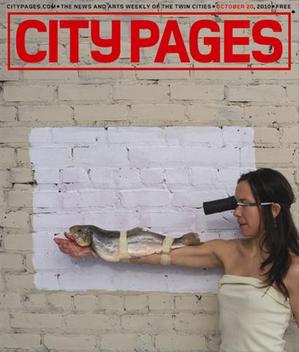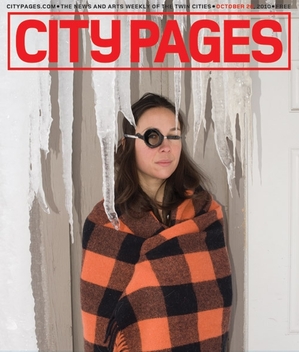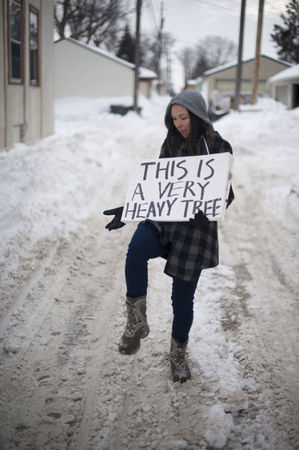Emily Johnson and Blackfish
by Caroline Palmer
The November performance of The Thank-You Bar, created by Minneapolis dance maker Emily Johnson with musicians James Everest and Joel Pickard of Blackfish, didn't begin inside a theater. Instead, audience members entered a gallery space in the Northrop Auditorium building. The exhibition on view, curated by Johnson with Carolyn Lee Anderson and titled "This Is Displacement: Native Artists Consider the Relationship Between Land and Identity," set the tone for a deeply personal examination of the constants and changes that shape an individual's relationship to home.
The next phase of the work took place on the Northrop stage, the site of so many transformative moments throughout the evening. Johnson wove together stories from her childhood in Alaska with connections to her Yup'ik identity and broader metaphorical observations about geographic dislocation. Along the way the choreographer even changed the way we looked at the theater itself as she shone a light into the rafters or danced in and out of the shadows. Throughout, Everest and Pickard supplied a texturally rich, live soundtrack, at times evoking mournful shouts from a distant past or a sense of rhythmic chaos appropriate for a restless, but not rootless, soul.
The Thank-You Bar showcased once again the eloquent, witty, smart, and singular perspective Johnson has shared so generously with the local dance community over the past decade. The performance's movement, music, storytelling, and video generated an entirely new sense of place that anyone would want to visit again and again.
Alec Soth shoots City Pages cover for Artists of the Year
by Kevin Hoffman
Shot by world renowned artist Alec Soth.
It's not every day that a fine artist of Alec Soth's caliber deems fit to grace the cover of a local alternative weekly. But that's just what happened with this week's City Pages.
For the cover of our annual Artists of the Year issue, Soth--himself one of the honorees--agreed to shoot Emily Johnson, a choreographer whose arresting dance is featured on the Northrup stage.
How did this happen? And who decided to bring the fish?
Back in January 2008, City Pages featured one of Soth's photos on the cover to illustrate a profile of Alec Soth written by Jeff Severns Guntzel. The story chronicled Soth's unlikely ascension from shy Chanhassen kid to overnight star of the New York photography world.
From all those miles up and down the river emerged a collection of photographs called "Sleeping by the Mississippi." The work won him his first major award: the 2003 Santa FeWhitney Museum in New York City were flying in to meet Soth. "I think they took pity on me," Soth says, only half-joking. By 2004, prints from his Mississippi project were hanging at the Whitney Biennial in New York City.
"As custom dictates," New York Times art critic Michael Kimmelman wrote in his review of the exhibit, there were "a few good discoveries (Alec Soth, a photographer)."
The tossed-off reference was enough to turn Soth into an overnight star. "It was just those four words, and it hasn't stopped since," says [Martin] Weinstein, who now represents Soth.
Since then, Soth's prints have hung in prestigious galleries and museums all over the world: Paris,Berlin, Beijing, and Sao Paulo. He's taken assignments from Esquire, W, Newsweek, GQ, and the New York Times. These days his large prints sell for as much as $20,000.
This year, Soth was selected as one of our annual Artists of the Year--the creative figures both local and national who made our lives just a little bit more interesting in 2010. As Marlon James (winner of the 2010 Minnesota Book Award for "The Book of Night Women") writes of Soth's particular artistic genius:
The thing about photographers, particularly brilliant ones like Alec Soth, is that they have a gift for capturing people in the increasingly rare act of being people. I'm not sure how he does it, especially in this age in which reality itself is up for grabs and everybody is a performer. Maybe he starts shooting at the point where most photographers stop. There is a casual intelligence here, the honesty of outtakes even though there was probably nothing casual in the process of taking them.
But even as we were preparing that text, we had no idea Soth would end up shooting the cover of the issue itself.
For answers to how that came about, I had to turn toCity Pages Art Director Mike Kooiman.
How did you end up commissioning Soth to do this week's City Pages cover?
Traditionally, the cover of Artists of the Year features a work from a painter, or similar kind of visual artist. This year we weren't featuring any of those, so when we looked down the list, we sought an alternate visual solution. Alec Soth is famous for a certain style of portraiture, so we thought he might be perfect for capturing the eccentricities of the work of someone like Emily Johnson (whose concepts and choreography reach beyond traditional boundaries). Luckily, both artists were on-hand and excited to participate.
What was the process like in terms of working with Soth to get the right image?
The process was pretty hands-off, aside from facilitating communication between photographer and subject. Alec preferred to talk with Emily personally in order to come up with a setting that suitedboth his own style and her work. The photo shoot was surprisingly varied, and many different kinds of shots from different environments were submitted. It's a challenge to choose the best shot for a cover like this. One one hand, our publication like all others has to sing from the stands. On the other, we want to be true to the style and spirit of the creators
Did they expense the fish?
I have not received any expense reports or receipts from the fishmonger.
But one question still remained: Why? The only one who could answer was Soth himself.
An artist of your stature doesn't ordinarily take time out to shoot the cover for a local alt weekly. What attracted you to this assignment?
The first freelance I ever did was for City Pages. It was a story about a dying mall. I remember being so incredibly proud to have my picture published. So I guess some of that has stayed with me. And I've always been a fan of the Artist of the Year issue. It is something I look forward to seeing each year. And lastly, I was thrilled to photograph a young, energetic talent like Emily Johnson.
What was the photo shoot like? It seems a bit chilly, and working with that fish couldn't have been easy.
I'm such a sucker for fresh snow. Given the opportunity, I'll always use it. I ended up shooting right outside of Emily's apartment. That way we could go and fetch her various props. Emily showed me this incredible fish skin she was sewing to make a lantern. It was so beautiful. But in the picture it just looked like a shirt. So we fetched some fresh fish from Coastal Seafood and I went a little crazy. In my head, the artist of the year might be the fish. Or maybe the whole thing was just a dream.
As for the fish: After its star turn on the cover of City Pages, it was eaten for dinner.
Emily Johnson on being photographed by Alec Soth
by Sheila Regan
Yup'ik choreographer, director, and curator Emily Johnson came to Minnesota 16 years ago from Sterling, Alaska. She now considers both places her home, often feeling pulled between them. Her connection to place is a large part of her work, which ranges from dance pieces to installations, often using the environment and senses to engage audiences. When Johnson found out that she was going to be photographed by Alec Soth, she was excited because she recognized that connection to place in his work as well. The following is an interview with Johnson about her experience working with Soth, and their snowy photo shoot.
What were you expecting when you found out you were going to be photographed by Alec Soth?
I've done lots of photo shoots before for different dances and for my company. We had a phone conversation. He asked, "What kinds of things do you like to do?" I made a list of ideas--that's how I approach photo shoots--I don't like dance movement type photos. Usually I like to do use location and think of activities and objects relevant to the piece I am working on. We had this amazing snowfall, and he was interested in working outside. We decided to meet at my place so we could look at props and costumes.
Expectation-wise, I love his work, so I was starstruck in that way. I was excited.
What was your reaction when you first saw his exhibition at the Walker?
I love his subjects in relation to place, like somebody looking through a window. Place seems so important--I work with location in my dances often, whether it's a site-specific piece or a building's history in relation to a community. I was drawn to the people in his pictures--not only to their faces and their look, but also in relation to where they were.
Do you have a favorite of his photographs?
I cut out one from one of the Walker brochures, it was one of my favorites. It's called Misty. It's of a woman in a blue swim cap.
What did you like about that piece?
I liked her expression, and the simplicity of it. The depth of her face. It's so oddly glamorous. Glamorous and dirty at the same time.
So what happened when he came over?
We looked at some of my props and costumes. I have worked a lot with fish in past photo shoots. That day I had been literally sewing a fish skin lantern. I told him, "No, I'm not done with the fish." I showed him the fish skin baskets and lanterns. We dug into old props from a piece of mine--fromThank You Bar--and we had some tea.
What were the props from Thank You Bar?
Some signs--very simple signs made on poster board. I make signs based on truth or something made up based on the theater we're in to draw people's attention to the space. There are 30 of them, anything from "this is a river" to "this is a graveyard" to "this is an emergency exit sign."
So then what happened?
We headed out. We found a location with lots of snow and icicles. We worked outside for rest of day.
Where was this?
In Minneapolis, outdoors in the snow. We worked in some alleyways, and on some snowdrifts. I liked that he was so directorial. I can direct photo shoots pretty well, but it was nice that he took the lead. He would pick a spot and we'd try a few things in that location. He'd get a sense of what he wanted me to try.
Did you have a jacket? Weren't you freezing?
We did a variety of shots, some with a blanket so I could stay warm, but some shots were with bare shoulders. It got pretty chilly.
How was it different from other photo shoots you've done?
I was a little star struck. I always get nervous for photo shoots. But in this case, I was especially nervous.
Did you build a rapport with him as the day went on?
It was comfortable as soon as he arrived. He was very nice. We got along well.
What's it like to be on the other side, being the subject of art as opposed to the creator?
It was two things happening at once. I liked being told what to do, but at the same time I wish I had a strong idea I could tell him--it was a little hard for me to give up that artistic control.
What is it about place that is important to you?
It's a pretty simple idea. We can't ignore the places that we're in, the places we work. Well, we do ignore that and then end up depleting world resources because we don't put as much thought or care into places as we should.

